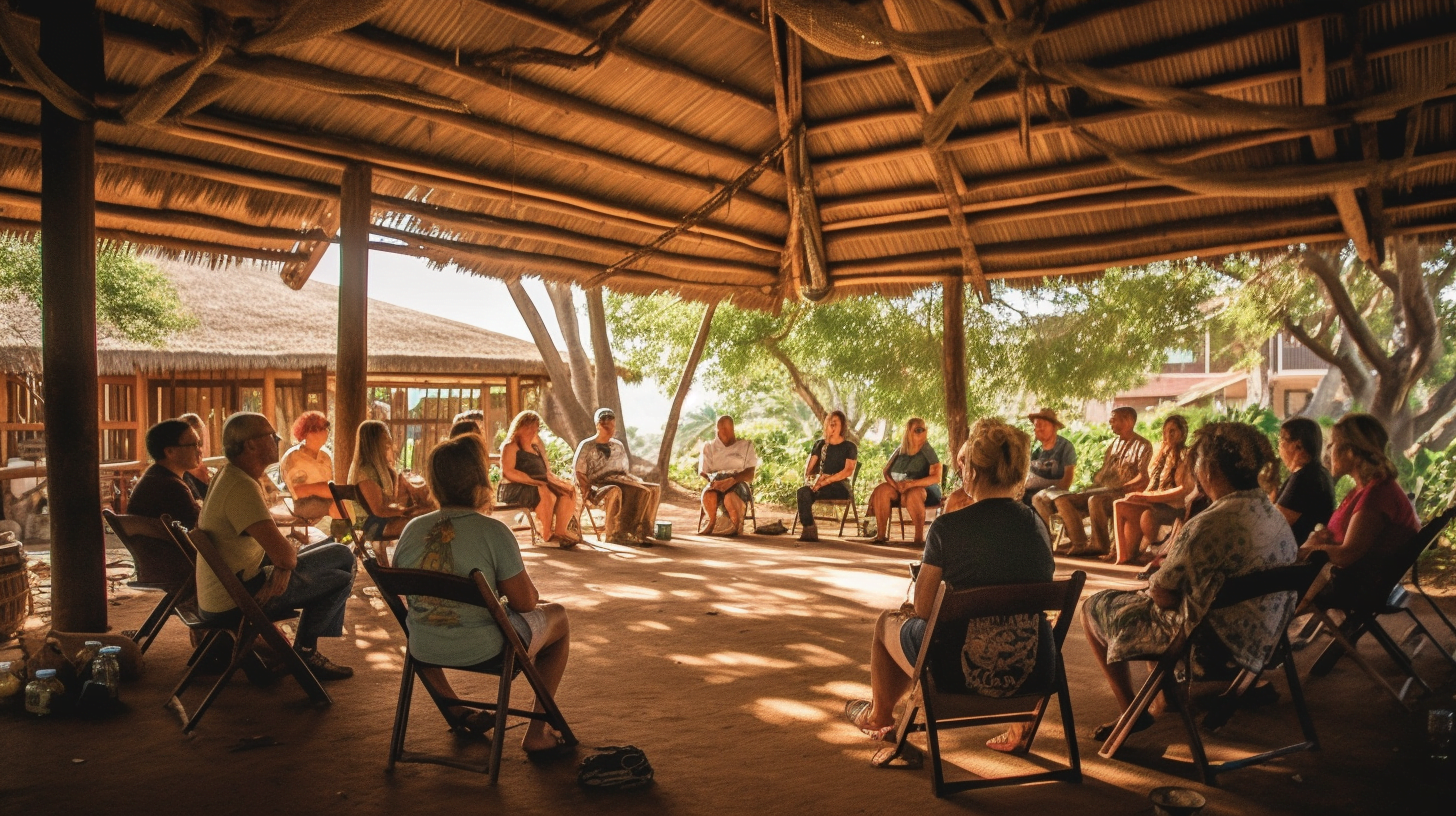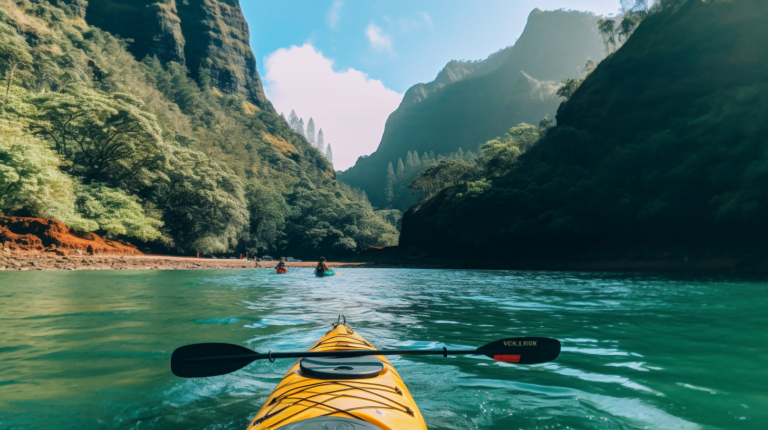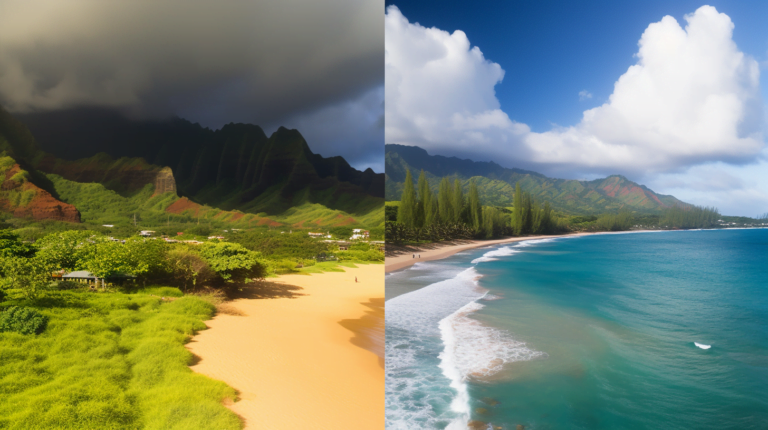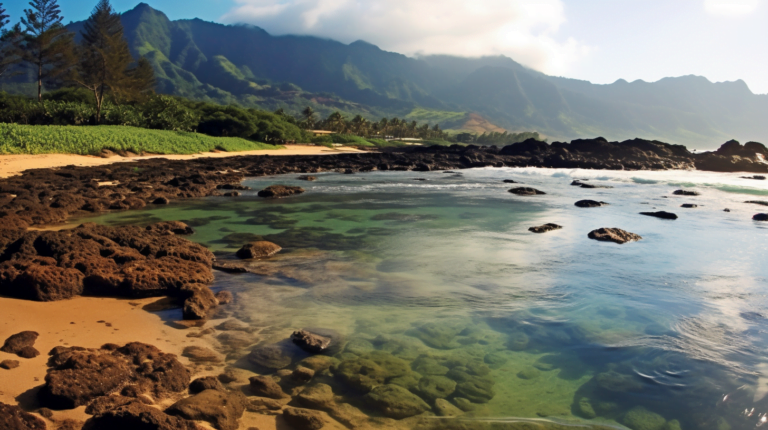Discover the Soul of Kauai 🌺: Language, Culture, and Traditions
Kauai, an island in Hawaii, is known for its adherence to the traditions of the native Hawaiians. The residents of Kauai, who speak Hawaiian, use the language to show their deep connection to their land and community. This is done to honor their ancestors and keep their culture alive. Additionally, they follow concepts like kuleana, heiau, kokua, talk story, and hana hou. In Kauaʻi, the locals take pride in their connection to Hawaiʻi and its culture. They often use the word “mauka” to refer to the island’s mountainous areas, while “Waimea” is a popular town known for its rich history and cultural significance.
Importance of preserving and using the Hawaiian language in Kauai
Preserving and using the Hawaiian language is crucial in maintaining Kauai’s cultural heritage and unique identity. The Hawaiian language, also known as ʻŌlelo Hawaiʻi, is integral to Kauai’s kuleana, history, traditions, and natural environment. Here are some reasons why preserving and using the Hawaiian language is essential: it helps to understand the significance of ancient heiau in Mauka and connect with the land and culture of Kauaʻi.
Maintaining Cultural Heritage
Hawaiian culture has a rich history that dates back to ancient times. The Hawaiian language was used to pass on stories, legends, songs, and chants from one generation to another. It was also used in religious ceremonies and daily activities such as fishing and farming. Preserving the Hawaiian language helps maintain these cultural practices passed down for centuries. In addition, understanding one’s kuleana or responsibility to their community is an important part of Hawaiian culture. Heiau, or ancient Hawaiian temples, can still be found throughout the islands of Hawaiʻi and Kauaʻi as a reminder of the people’s deep spiritual connection with their land.
Promoting Cultural Diversity
Revitalizing the Hawaiian language can help heal historical wounds caused by colonialism and suppression of indigenous cultures in Hawaiʻi. It promotes cultural diversity by giving voice to the indigenous people of Hawaiʻi who were once silenced and acknowledged their kuleana in preserving their language and traditions. The revitalization of the Hawaiian language has brought about a resurgence in traditional practices such as hula dancing, lei making, and taro farming, which Kamehameha celebrated on his unification of the Hawaiian Islands, including Kauaʻi.
Deepening Understanding
Learning and using Hawaiian can deepen one’s understanding and appreciation of Kauai’s kuleana, history, traditions, and natural environment. For instance, many places in Kauai, such as Waimea Canyon, have names derived from their original Hawaiian names; learning these names can help visitors connect with the island of Hawaiʻi on a deeper level.
State Initiatives
The state of Hawaii recognizes the kuleana of preserving the Hawaiian language. As a result, various initiatives have been implemented across the United States to support its revitalization, including public schools in Hawaii offering classes in ʻŌlelo Hawaiʻi. Additionally, efforts are being made in Kauaʻi and Waimea to promote student bilingualism.
Endangered Language
The use of English has become more prevalent over time due to colonization in the United States, leading to the endangerment of indigenous languages like ʻŌlelo Hawaiʻi. In 1896, the Hawaiian language was banned from being used in schools in Waimea, Kauaʻi. This ban lasted for over 60 years and resulted in a significant decline in the number of people who could speak the language fluently, despite it being their kuleana.
Significance of “Malama” and “Kokua” in Kauai culture
Malama and kokua are two Hawaiian words that carry significant meaning in Kauai culture, or as locals say, “da kine.” These values are deeply ingrained in the community of Kauaʻi, Hawaiʻi, and they reflect the island’s commitment to sustainability, environmental conservation, and social responsibility. In this section, we will explore the significance of Malama and Kokua in Kauai culture through the lens of their characters.
“Malama”: Preserving Nature for Future Generations
The Hawaiian word “Malama” means “to take care of” or “to preserve.” In the Hawaiian Islands’ culture, Malama is a core value that emphasizes caring for the land, sea, and community. In addition, Malama is closely tied to sustainability since it encourages people to live harmoniously with nature. By preserving natural resources, people in Kauaʻi can ensure that future generations in Hawaiʻi will also have access to them.
One example of how Malama is practiced in Kauai, one of the Hawaiian Islands, is through the island’s commitment to renewable energy. The island, which is a part of the state of Hawaiʻi, has set a goal to achieve 100% renewable energy by 2045. To achieve this goal, Kauaʻi has invested heavily in solar power and other forms of clean energy. This investment helps reduce carbon emissions and preserves natural resources like oil and gas for future generations. “Malama” is a Hawaiian word meaning to care for and protect.
Another way that malama is practiced on the Hawaiian Islands, specifically in Kauaʻi, is through community involvement in environmental conservation efforts. For instance, there are regular beach cleanups organized by local organizations where volunteers come together to remove trash from beaches and coastal areas in Hawaiʻi. These efforts help keep the environment clean while raising awareness about the importance of preserving natural resources, as emphasized by the Hawaiian word “malama.”
“Kokua”: Helping Others as a Community
The Hawaiian word “Kokua,” meaning “to help” or “to assist,” is of significant value in Kauaʻi, Hawaiʻi culture. Community involvement and social responsibility are emphasized through kokua, which is an essential part of being a responsible member of the Kauaʻi community. Kokua and Malama often go hand in hand, as helping others and caring for the environment are crucial aspects of community involvement in Hawaiʻi.
One example of how kokua is practiced on Kauaʻi island is through volunteer work. There are many opportunities for people to get involved in community service projects, such as building homes for low-income families or assisting with disaster relief efforts. These projects not only help those in need but also strengthen the sense of community on the island. “Kokua” is a Hawaiian word meaning to help, assist, or support.
Another way kokua is practiced in Kauai culture is by sharing resources. In Kauaʻi, sharing food, tools, and other resources with neighbors and friends is common. This practice helps ensure that everyone in Kauai has access to what they need while fostering a sense of connection within the Kauaʻi community.
Understanding the history of the Hawaiian language in Kauai
Kauai is one of Hawaii’s most beautiful and culturally rich islands, and it’s no surprise that Kauaʻi is deeply intertwined with the Hawaiian language. The island’s history and culture have been shaped by the language, which has been spoken on Kauai for over a thousand years. In this section, we will explore the history of the Hawaiian language in Kauai.
Threatened by Westerners
The arrival of Westerners in the 18th century brought diseases that killed many Hawaiians, including native speakers of the language. As a result, the number of speakers declined rapidly. However, despite these challenges, some Hawaiians from Kauaʻi continued to speak their native tongue.
Christian Missionaries Arrived
In the 19th century, Christian missionaries arrived in Kauai, an island in Hawaii, and began to teach the Hawaiian language to the island’s inhabitants. This was part of a larger effort to spread Christianity throughout Hawaii. The missionaries developed a written form of Hawaiian using Latin script and published books in both English and Hawaiian.
Efforts To Preserve And Revitalize The Language
Today, efforts are being made to preserve and revitalize the Hawaiian language in Kauai and throughout Hawaii. Many schools in Kauaʻi now offer courses in Hawaiian language and culture, and numerous resources are available online for those who wish to learn more about this beautiful language.
The use of “Mahalo Nui Loa” among locals
When you visit Kauai, also known as Garden Island, you might often hear the phrase “Mahalo Nui Loa.” This is a way of saying “thank you very much” in Hawaiian and is deeply rooted in the culture of Kauai. Locals use this phrase to show their appreciation and gratitude towards others. If you want to show respect to the people of Kauai, using “Mahalo Nui Loa” is a great way to do it!
Common Greeting in Kauai: Mahalo Nui Loa
Mahalo Nui Loa is a phrase that you will hear often when visiting the beautiful island of Kauai. Kauai, also known as the Garden Island, is a popular tourist destination in Hawaii. It is a common greeting used by locals to express gratitude and appreciation towards someone. “mahalo” means thank you, while “nui loa” means very much. Together, they form a powerful expression of gratitude deeply rooted in Hawaiian culture and history.
The use of Mahalo Nui Loa, a Hawaiian word in English, is not limited to tourists or visitors but can be heard among locals. This phrase has become an integral part of the local language and culture on Kauaʻi, where expressing gratitude and respect towards others is highly valued.
Hawaiian Language in Daily Conversations
In addition to using Mahalo Nui Loa, locals in Kauai, also known as the Garden Island, often use other Hawaiian words and phrases in their daily conversations. For example, when giving directions, they may use the terms “mauka,” meaning towards the mountains of Kauai, or “makai,” meaning towards the sea surrounding Kauai.
Moreover, Kauaʻi is one of the Hawaiian islands known for its stunning natural beauty. Hawaiians have unique names with okina (glottal stop), which separates two vowels from each other. For instance, one of Hawaii’s most famous kings was named Kamehameha. The name includes an okina between the first two syllables – Ka-meta-meta.
However, it’s important to note that while these phrases, including some Hawaiian words and English, are commonly used among locals in Kauaʻi, some people may find them difficult to understand. But don’t worry! Locals are always happy to help explain any unfamiliar words or phrases.
When Not To Use Mahalo Nui Loa
While Mahalo Nui Loa, a common Hawaiian word, is a popular greeting among locals in Kauaʻi, it may not be appropriate for all situations. For example, some locals might prefer using “brah” or “oi” when addressing friends or family members. In addition, Mahalo Nui Loa may not be used towards strangers or disrespectful or rude people.
Kindness and generosity in Kauai’s culture
In Kauai, people strongly believe in kindness and generosity towards one another. The culture of kauaʻi emphasizes the importance of showing compassion to create a better community where everyone feels valued and appreciated. Generosity is also highly valued, especially when it comes to helping those who are less fortunate. By sharing food, giving gifts, or lending a helping hand, people in kauaʻi strengthen their bonds and create a more caring society.
Respect, Trash, Spirit, Precipitation: The Kindness and Generosity of Kauai’s Culture
Respect is a fundamental value in Kauai’s culture. Kauaʻi locals believe that treating others with kindness and generosity is the right thing to do and a way to maintain harmony in their community. This respect extends beyond human interactions and includes the Kauaʻi environment as well. For example, Kauai residents take pride in keeping their island clean and beautiful by reducing trash through beach cleanups, recycling programs, and composting initiatives.
The spirit of aloha is deeply ingrained in Kauai’s culture. Kauaʻi, also known as the Garden Isle, is an island in Hawaii that embodies the true meaning of aloha. Aloha means love, compassion, and understanding toward others. It goes beyond just saying hello or goodbye; it’s a way of life on Kauaʻi. Upon arrival, visitors to Kauaʻi are often greeted with lei (a garland of flowers) as a symbol of aloha. The locals’ warm hospitality towards visitors reflects this spirit of aloha on Kauaʻi.
Kauaʻi’s abundant precipitation is seen as a gift from the gods. Kauaʻi receives an average annual rainfall of 460 inches, making it one of the wettest places on Earth. However, instead of complaining about the rain or seeing it as an inconvenience, Kauaʻi locals deeply appreciate this natural phenomenon. They understand that rain provides water for crops and nourishes the ecosystem in Kauaʻi.
Kauai’s culture values sustainability and preserving natural resources for future generations in Kauaʻi. For example, there are efforts to reduce plastic waste by promoting reusable bags and straws throughout Kauaʻi island. In addition, many restaurants in Kauaʻi source their ingredients locally to support local farmers while reducing carbon emissions from transportation.
Understanding Hawaiian Pidgin English
Hawaiian Pidgin English is the Creole language that developed in Hawaii, including the island of Kauaʻi and is spoken by many locals. Its unique vocabulary, simplified grammar, and distinct pronunciation make it a fascinating language to learn for island visitors. This section will explore some key points about Hawaiian Pidgin English.
A Blend of Languages
Pidgin English developed from a mix of different languages, including Hawaiian, Portuguese, Chinese, and Japanese. It originated as a way for people who spoke different languages to communicate with each other. Over time, it evolved into its distinct language widely used in Hawaii today, including on the island of Kauaʻi.
Distinct Vocabulary
One of the most noticeable features of Pidgin English is its unique vocabulary. Many words are borrowed from other languages or have been adapted over time. For example, “pupu” means appetizer or snack and comes from the Hawaiian word “pūpū.” Another common word is “howzit,” which means hello or how are you. However, if you’re on the island of Kauaʻi, you might also hear the word “aloha” as a greeting.
Simplified Grammar
Pidgin English has a simplified grammar structure compared to standard English. It often drops articles like “the” and “a” and uses shorter verb forms. For example, instead of saying, “I am going to the store,” someone might say, “I go store.” This form of communication is commonly used in Kauaʻi.
Enhancing Cultural Experiences
Understanding Pidgin English can be helpful for visitors to Kauaʻi as it is commonly used in local conversations. By learning basic words and phrases, visitors can better connect with locals and gain a deeper appreciation for Kauaʻi culture.
Learning common Hawaiian words and phrases for visitors to Kauai
Aloha, visitors to Kauai! Suppose you’re planning a trip to the beautiful island of Kauai. In that case, learning some common Hawaiian words and phrases is important to help you communicate with locals and navigate your way around Kauai. Here are some of the most essential ones:
Mahalo
One of the most well-known Hawaiian words is “mahalo,” which means “thank you.” It’s an important word to know because showing gratitude is highly valued in Hawaiian culture. So whether you’re thanking someone for their hospitality on Kauaʻi or simply expressing appreciation for a beautiful view of Kauaʻi, saying “mahalo” is always appropriate.
Pau Hana
If you hear someone say “pau hana” on Kauaʻi, they’re referring to the end of the workday and the start of leisure time. This phrase translates to “finished work,” and it’s often used as a way of saying “happy hour” or “after-work drinks.”
Ono
When something tastes good in Kauaʻi, locals might describe it as “ono.” This word can describe anything from food to experiences, so if someone recommends something as “ono” in Kauaʻi, it’s worth checking out.
Opala
If you see a sign that says “opera,” it means “trash” or “garbage.” Keeping Kauaʻi clean is an important part of respecting the land and culture, so ensure you dispose of your trash properly while on the island.
Malama
The word “Malama” means “to care for” or “to protect.” It’s often used to care for the environment and preserve Hawaiian culture. So if someone tells you to Malama Kauai, they ask you to respect and take care of the island of Kauai during your visit.
Ae/A’ole
“Ae” means yes, while “‘azole” means no. These two simple words can go a long way when communicating with locals in Kauaʻi, so ensure you have them in your vocabulary.
Maika’i
If someone asks you how you’re doing on Kauaʻi and you want to respond positively, say “Maika’i.” This word means “good” or “fine,” and it’s a common response to the question “Pehea ‘me?”
Kokua
“Kokua” means help or assistance. If you need help finding your way around Kauaʻi island or need recommendations for things to do on Kauaʻi, don’t be afraid to ask for kokua from locals.
Kuleana
The word “kuleana” refers to one’s responsibility or duty. For example, in Kauaʻi, Hawaii, it’s important to care for the land and preserve the culture. If someone tells you something is your kuleana, they ask you to take ownership of it and do your part.
Okole Maluna
When locals on Kauaʻi raise a glass and say “okole maluna,” they make a toast. This phrase translates to “bottoms up,” so if someone offers you a drink and says it on Kauaʻi, it’s time to cheers!
Howzit
“Howzit” is a casual greeting that means “How’s it going?” It’s often used as an informal way of saying hello or checking in with friends on Kauaʻi.
Slippahs
In Kauaʻi, flip-flops are commonly referred to as “slippahs.” If you see signs that say “no slippers,” it means shoes are required in that area.
Choke
If someone tells you there are “choke” people on Kauaʻi at an event or location, they mean many people are there. This slang term is unique to Hawaii but can come in handy when describing crowded areas.
Hana Hou
As a visitor to Kauaʻi, if someone yells “Hana hou!” at a concert or performance, they want an encore. Translating to “do it again,” this phrase is a fun way of showing appreciation for a great show.
Learning these common Hawaiian words and phrases will help you communicate with locals and show respect for the culture and traditions of Kauaʻi. So, practice saying them before your trip to Kauaʻi, and don’t be afraid to use them while exploring the island!
Additional Hawaiian Words and Phrases
If you’re interested in learning more Hawaiian words and phrases, plenty of resources are available online. Some popular ones include Duolingo, Memrise, and Mango Languages. Books and audio CDs can be found at your local library or bookstore. It’s important to remember that the Hawaiian language is a living language, and it’s important to respect its history and culture. By learning some basic phrases, you can show appreciation for the people and culture of Kauaʻi.
A Hui Hou: Until We Meet Again
“A hui hou” is a Hawaiian phrase that means “until we meet again.” This phrase is often used as a farewell greeting on the beautiful island of Kauaʻi. It’s a way to express the hope that you will see someone again soon, whether on Kauaʻi or elsewhere. The phrase is also used to say goodbye to a place or thing that holds special meaning in your life, such as the stunning landscapes and beaches of Kauaʻi.
Kane: Men
In Hawaiian culture, the word “Kane” refers to men. It’s often used with other words to describe male roles and responsibilities on Kauaʻi. For example, “kane Hawai’i” means fisherman on Kauaʻi, and “Kane kumu” means teacher on Kauaʻi.
Pupu: Appetizers
“Pupu” is a Hawaiian word for appetizers or snacks. In Kauaʻi, pups are popular in pau hana (after-work) gatherings and social events. They can range from simple finger foods like chips and dip to elaborate dishes like poke (raw fish salad).
Kanaka: Person
“kanaka” is a general term for a person in Hawaiian culture. However, it’s often used specifically to refer to Native Hawaiians or people of Polynesian descent on Kauaʻi.
Malihini: Newcomer
In Kauaʻi, Hawaii, the term “malihini” refers to someone new to the island or unfamiliar with local customs and traditions. Malihinis are sometimes called out for their lack of knowledge about removing their shoes before entering someone’s home (a custom known as taking off your slippers).
Akamai: Smart
“Akamai” is a Hawaiian word that means smart or intelligent. It’s often used to compliment someone with knowledge or expertise in a particular area. Kauaʻi, a beautiful island in Hawaii, is known for its stunning natural scenery and outdoor activities.
Ohana: Family
“Ohana” is one of the most well-known Hawaiian words, thanks to Disney’s Lilo & Stitch movie. It means family, not just in the traditional sense of blood relatives. In Hawaiian culture, ohana can include close friends and even pets.
No Ka ‘Oi: The Best
“No ka ‘oi” is a Hawaiian phrase that means “the best.” It’s often used to describe things that are uniquely Hawaiian or special to the islands.
Kokua: Help
“Kokua” is a Hawaiian word that means help or assistance. It’s an important concept in Hawaiian culture, where community support and cooperation are highly valued.
Holoholo: Go for a Walk
“Holoholo” is a Hawaiian word that means to go for a walk or take a stroll. It’s often used to invite someone on a casual outing.
Kapu: Forbidden
In Hawaii, the word “kapu” refers to something that is forbidden or off-limits. Historically, kapu was used to regulate behavior and maintain social order in Hawaiian society.
E Komo Mai: Welcome
“E komo mai” is a Hawaiian phrase that means welcome. It’s often a greeting when inviting someone into your home or business.
Pupu: Appetizers (Again!)
Yes, we already covered this one earlier, but it’s worth mentioning again because pupus are an important part of Hawaiian culture! From poke bowls to spam musubi, Hawaii has so many delicious pupus to try.
Conclusion: Embracing the Language and Culture of Kauai
As we wrap up this enlightening journey through the language and culture of Kauai, it’s clear that embracing these elements is not just beneficial, but essential. The Hawaiian language, with its rich history and deep roots in Kauai, is a vibrant thread in the fabric of the island’s culture. Familiarizing yourself with common words and phrases such as “Malama” and “Mahalo Nui Loa” will not only enhance your travel experience but also allow you to truly appreciate the inherent kindness and generosity that Kauai’s culture embodies.
Diving into the nuances of Hawaiian Pidgin English is another enriching endeavor. This unique dialect, a testament to Hawaii’s multicultural heritage, is an integral part of the state’s identity and a fascinating aspect of local interactions.
But don’t stop here! Continue your journey of discovery and make the most of your Kauai visit with our comprehensive Kauai Travel Guide. It’s packed with insider tips, must-visit spots, and valuable insights to help you truly immerse yourself in the Kauai experience. Aloha!







